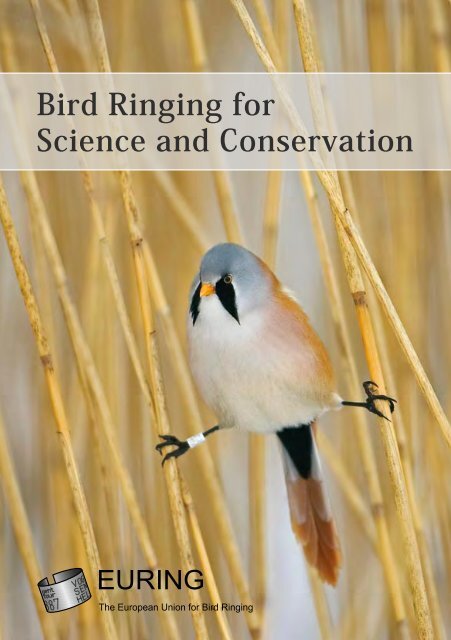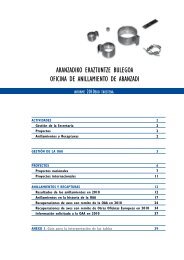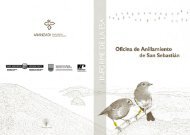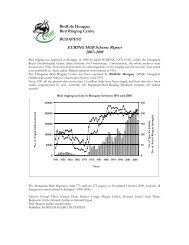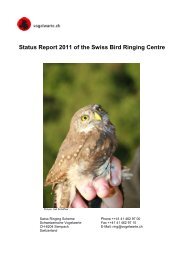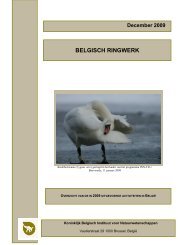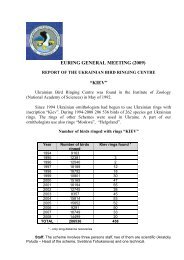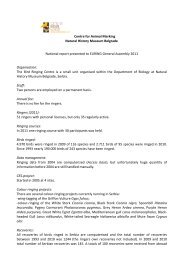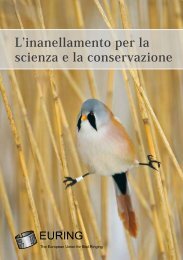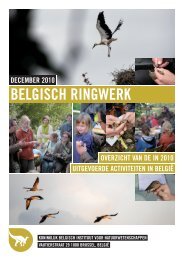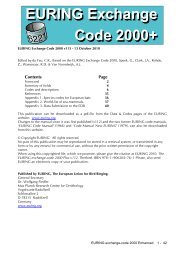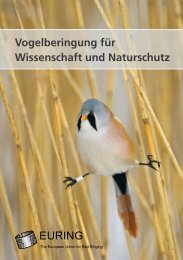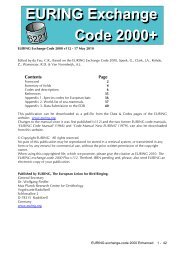Bird Ringing for Science and Conservation - The European Union ...
Bird Ringing for Science and Conservation - The European Union ...
Bird Ringing for Science and Conservation - The European Union ...
- No tags were found...
Create successful ePaper yourself
Turn your PDF publications into a flip-book with our unique Google optimized e-Paper software.
<strong>Bird</strong> <strong>Ringing</strong> <strong>for</strong><br />
<strong>Science</strong> <strong>and</strong> <strong>Conservation</strong><br />
EURING<br />
<strong>The</strong> <strong>European</strong> <strong>Union</strong> <strong>for</strong> <strong>Bird</strong> <strong>Ringing</strong>
<strong>Bird</strong> <strong>Ringing</strong> <strong>for</strong> <strong>Science</strong> <strong>and</strong> <strong>Conservation</strong><br />
<strong>Bird</strong> <strong>Ringing</strong> <strong>for</strong> <strong>Science</strong> <strong>and</strong> <strong>Conservation</strong><br />
Preface<br />
What is Scientific <strong>Bird</strong> <strong>Ringing</strong><br />
We live in a rapidly changing world<br />
where human activities are causing rapid<br />
declines in many species of animals <strong>and</strong><br />
plants, linked to widespread environmental<br />
change. Within a few decades it is predicted<br />
that global climate change will<br />
bring about even greater changes than we<br />
have seen so far. Action to address these<br />
issues must be based on sound science.<br />
In<strong>for</strong>mation concerning the status of our<br />
wildlife resources is needed <strong>for</strong> effective<br />
targetting of conservation action, while<br />
robust underst<strong>and</strong>ing of ecological processes<br />
is essential <strong>for</strong> predicting the effects<br />
of policy <strong>and</strong> management actions.<br />
<strong>Bird</strong>s are excellent tools <strong>for</strong> monitoring<br />
<strong>and</strong> underst<strong>and</strong>ing environmental<br />
change, as well as being a charismatic<br />
wildlife resource that brings enjoyment<br />
to many millions of people. <strong>Bird</strong> <strong>Ringing</strong><br />
involves the marking of individual birds by<br />
highly trained ornithologists to provide vital<br />
data on migration patterns, demography<br />
<strong>and</strong> ecological processes. We are <strong>for</strong>tunate<br />
that many volunteers contribute<br />
to this activity, allowing us to study populations<br />
at large spatial scales. In Europe<br />
these activities are organized by national<br />
ringing centres in each country, co-ordinated<br />
by EURING. This brochure explains<br />
how these activities are contributing to<br />
conservation science, <strong>and</strong> how they can be<br />
developed further to address some of the<br />
conservation challenges of the 21st century.<br />
We hope that it will provide a useful<br />
overview <strong>for</strong> conservationists, policy makers<br />
<strong>and</strong> environmental scientists, <strong>and</strong> that<br />
it will also be of interest to all those who<br />
are concerned about how <strong>and</strong> why our<br />
bird populations are changing.<br />
Stephen Baillie, Chairman of EURING<br />
Scientific bird ringing is a research method<br />
based on the individual marking of birds.<br />
Any record of a ringed bird, either through<br />
recapture <strong>and</strong> subsequent release, or on<br />
the occasion of its final recovery as a dead<br />
bird, will tell us much about its life. This<br />
technique is one of the most effective<br />
methods to study the biology, ecology, behaviour,<br />
movement, breeding productivity<br />
<strong>and</strong> population demography of birds.<br />
Tracking back the journeys of ringed<br />
birds allows us to define their migratory<br />
routes <strong>and</strong> staging areas, so providing crucial<br />
in<strong>for</strong>mation <strong>for</strong> the planning of integrated<br />
systems of protected areas <strong>for</strong> our<br />
birds. Other in<strong>for</strong>mation derived from recoveries<br />
<strong>and</strong> recaptures include population<br />
parameters (e.g. survival estimates,<br />
lifetime reproductive success), which<br />
are essential to determine the causes of<br />
changes in population sizes.<br />
Much of the data <strong>for</strong> this work are gathered<br />
by well-trained ”professional amateurs”<br />
whose motivation is not money but<br />
the simple privilege of working with birds<br />
<strong>for</strong> the ultimate purpose of conservation.<br />
Because almost 4 million birds are ringed<br />
annually in Europe alone <strong>and</strong> because<br />
many birds migrate freely across political<br />
boundaries, the use of individual rings <strong>and</strong><br />
the collection of data from birds recovered<br />
need efficient organisa tion. A network<br />
of fully co-ordinated ringing stations<br />
<strong>and</strong> National <strong>Ringing</strong> Schemes has been<br />
indispensable <strong>for</strong> the management of scientific<br />
bird ringing in Europe. EURING, the<br />
<strong>European</strong> <strong>Union</strong> <strong>for</strong> <strong>Bird</strong> <strong>Ringing</strong>, guarantees<br />
the efficient collaboration among national<br />
ringing schemes.<br />
Matthias Kestenholz<br />
Marcel Burkhardt<br />
<strong>Bird</strong> ringing data are useful in both<br />
research <strong>and</strong> management projects. Individual<br />
identification of birds makes possible<br />
studies of dispersal <strong>and</strong> migration,<br />
behaviour <strong>and</strong> social structure, life-span<br />
<strong>and</strong> survival rate, reproductive success<br />
<strong>and</strong> population growth.<br />
<strong>The</strong> main aim of ringing is to gain results<br />
which can be used in research <strong>and</strong> management.<br />
<strong>Ringing</strong> is not a goal in itself,<br />
but a scientific method of collecting desired<br />
in<strong>for</strong>mation on the life of birds.<br />
1
<strong>Bird</strong> <strong>Ringing</strong> <strong>for</strong> <strong>Science</strong> <strong>and</strong> <strong>Conservation</strong><br />
<strong>Bird</strong> <strong>Ringing</strong> <strong>for</strong> <strong>Science</strong> <strong>and</strong> <strong>Conservation</strong><br />
<strong>Bird</strong>s are personalities<br />
Outst<strong>and</strong>ing individuals<br />
Individuals of the same species <strong>and</strong> sex<br />
have behavioural <strong>and</strong> physiological differences,<br />
even in st<strong>and</strong>ard conditions. In<br />
humans, many of these differences are<br />
treated as expressions of individual variation<br />
in personality. Yet in other animals,<br />
such explanations have often been neglected,<br />
the differences interpreted instead<br />
as either the consequence of inaccurate<br />
measurements or as non-adaptive<br />
variation.<br />
Putting a ring to a bird’s leg makes the<br />
bird a recognizable individual whose individual<br />
life history <strong>and</strong> fate can be followed.<br />
Personalities are general properties<br />
of birds, other animals, <strong>and</strong> humans.<br />
Recent studies in birds suggest that animal<br />
personality can be studied objectively.<br />
Such work has used four approaches in<br />
parallel: (1) descriptive studies, including<br />
the investigation of links among several<br />
behaviours <strong>and</strong> their specificity across situations,<br />
(2) genetic <strong>and</strong> physiological research<br />
on causal mechanisms underlying<br />
relations among several behaviours of the<br />
same profile, (3) ontogenetic studies on<br />
plasticity <strong>and</strong> environmental malleability,<br />
<strong>and</strong> (4) field studies on survival <strong>and</strong> reproduction<br />
towards underst<strong>and</strong>ing how<br />
different types of personality are maintained.<br />
Different personality types may react<br />
differently to environmental changes<br />
<strong>and</strong> may show differential vulnerability<br />
to stress, leading to differences in welfare.<br />
Ultimately, such differences can have major<br />
impacts on individual fitness, response<br />
to environmental change, geographic distribution,<br />
<strong>and</strong> even rates of speciation.<br />
<strong>Ringing</strong> birds individually allows us to follow<br />
even the most exceptional personal<br />
fates.<br />
<strong>The</strong> oldest wild bird ever recorded could<br />
be a Manx Shearwater captured on a little<br />
isl<strong>and</strong> off north Wales. <strong>The</strong> venerable<br />
bird was first captured <strong>and</strong> ringed by ornithologists<br />
in May 1957, when it was fullgrown,<br />
hence between four <strong>and</strong> six years<br />
old. It had been caught in 1961, 1978 <strong>and</strong><br />
2002, when a warden of the Bardsey isl<strong>and</strong><br />
<strong>Bird</strong> Observatory caught the seabird<br />
again. <strong>The</strong> shearwater‘s possible age of 52<br />
years could make it the record holder. Until<br />
now, the world‘s oldest ringed bird was<br />
a US albatross estimated to be over 50.<br />
One of the longest journeys ever recorded<br />
is from a Common Tern ringed<br />
on 27 June 2003 as a nestling in Hälsingl<strong>and</strong><br />
in central Sweden <strong>and</strong> found dead<br />
on 1 December 2003 on Stewart Isl<strong>and</strong> in<br />
New Zeal<strong>and</strong>. If we assume a normal route<br />
from Sweden to South Africa <strong>and</strong> then to<br />
New Zeal<strong>and</strong>, the tern might have covered<br />
25,000 kilometres. Measured as straight<br />
line distances, the tern’s journey is “only”<br />
17,508 km.<br />
<strong>The</strong> rate of migration is quite different<br />
from that attained in flights <strong>for</strong> short<br />
distances. <strong>The</strong> fastest journey is from a<br />
ringed <strong>European</strong> Barn Swallow Hirundo<br />
rustica that flew in 27 days from Umhlange,<br />
Kwa Zulu Natal, South Africa, to<br />
Whitley Bay, United Kingdom.<br />
A Black-headed Gull was ringed as a<br />
fledgling on 29 June 1996 in Hämeenkyrö<br />
county, Pirkanmaa, Finl<strong>and</strong>. <strong>The</strong> metal ring<br />
was sighted with a telescope on the 3 <strong>and</strong><br />
7 January 2000 in Fort Worth, Texas, USA.<br />
<strong>The</strong> bird was back again to its wintering<br />
quarters in Texas on 30 November 2000.<br />
Helmut Kruckenberg<br />
Steve Stansfield<br />
Beat Walser<br />
Special rings <strong>and</strong> various other marks can be used to identify birds at a distance<br />
without needing to catch them again. <strong>The</strong>se White-fronted Geese were marked with<br />
colour neck b<strong>and</strong>s, each individually identified by numbers or letters.<br />
<strong>The</strong> old Manx Shearwater must have<br />
flown at least eight million kilometres<br />
during its long life.<br />
Common Terns migrate between the two<br />
hemispheres <strong>and</strong>, by this, experience both<br />
northern summer <strong>and</strong> austral summer.<br />
2<br />
3
<strong>Bird</strong> <strong>Ringing</strong> <strong>for</strong> <strong>Science</strong> <strong>and</strong> <strong>Conservation</strong><br />
<strong>Bird</strong> <strong>Ringing</strong> <strong>for</strong> <strong>Science</strong> <strong>and</strong> <strong>Conservation</strong><br />
Methods of bird ringing<br />
Many birds are ringed as chicks in nests<br />
but fully-grown birds have to be caught<br />
using a variety of nets <strong>and</strong> traps. Whatever<br />
the catching method, ringers are<br />
carefully trained to ensure the safety<br />
of the birds they ring. Small birds are<br />
often caught in fine mist-nets. Bigger<br />
birds, such as ducks, are often caught<br />
in “walk-in” or baited cage traps. After<br />
removal from a net or a trap, birds<br />
are usually placed in soft cotton bags<br />
or in special holding boxes where they<br />
remain quiet <strong>and</strong> dry until they can be<br />
identified, ringed, examined <strong>and</strong> released.<br />
Special rings <strong>and</strong> various other marks<br />
can be used to identify birds at a distance<br />
without needing to catch them<br />
again. Many birds wear colour rings with<br />
numbers that can be easily read through<br />
a telescope. Waterbirds can be marked<br />
with colour neck b<strong>and</strong>s, <strong>and</strong> larger birds<br />
marked with wing tags, each individually<br />
identified by numbers or letters.<br />
<strong>Bird</strong> ringing <strong>for</strong> scientific purposes started<br />
in Denmark in 1889, when H. Chr. C.<br />
Mortensen released Starlings that were<br />
fitted with metal rings engraved with<br />
successive numbers <strong>and</strong> a return address.<br />
Since those pioneer times, bird ringing<br />
quickly evolved into a st<strong>and</strong>ard research<br />
technique used in all parts of the World.<br />
Viborg Stiftsmuseum<br />
Joël Krebs<br />
Many birds like this Tawny Owl are<br />
ringed as chicks in nests.<br />
A row of mist-nets at the bird ringing<br />
site Col de Bretolet in the Swiss Alps. By<br />
co-ordinating the activities of ringing<br />
stations throughout Europe <strong>and</strong> Africa,<br />
EURING is helping to unravel the mysteries<br />
of bird migration.<br />
Matthias Kestenholz<br />
Waterbirds like ducks are often caught in baited cage traps.<br />
A wide variety of<br />
ring sizes is used<br />
to mark different<br />
species, depending<br />
on the dimension<br />
<strong>and</strong> structure of<br />
the leg <strong>and</strong> the<br />
habitats the birds<br />
live in. <strong>The</strong> weight<br />
increase to the<br />
bird from the ring<br />
can be roughly<br />
compared to that<br />
of a wristwatch<br />
<strong>for</strong> a human.<br />
Geert Brodvad<br />
Matthias Kestenholz<br />
4<br />
5
<strong>Bird</strong> <strong>Ringing</strong> <strong>for</strong> <strong>Science</strong> <strong>and</strong> <strong>Conservation</strong><br />
<strong>Bird</strong> <strong>Ringing</strong> <strong>for</strong> <strong>Science</strong> <strong>and</strong> <strong>Conservation</strong><br />
Mist-nets are made of very thin nylon<br />
threads <strong>and</strong> are cheap <strong>and</strong> safe <strong>for</strong><br />
catching small birds, such as this male<br />
Lesser Redpoll.<br />
Kurt Pulfer<br />
Kurt Pulfer<br />
Satellite tracking<br />
One method that has added a new dimension to avian research in recent years is satellite<br />
tracking. Tiny transmitters, usually carried in harnesses strapped to the birds’ bodies,<br />
are linked to satellites. Each harness is custom-designed <strong>for</strong> each species <strong>and</strong> manually<br />
adjusted <strong>for</strong> each bird <strong>for</strong> maximum com<strong>for</strong>t of fit. <strong>The</strong> system enables researchers <strong>and</strong><br />
conservationists to track individual birds continuously.<br />
<strong>The</strong> results achieved by satellite tracking are ground-breaking. For the first time, the<br />
whole spatio-temporal pattern of successful migrations can be captured at a level of<br />
detail far exceeding that provided by ringing. Satellite tracking can also help discover unknown<br />
breeding, moulting or wintering areas of endangered species or causes of massive<br />
losses. When combined with other devices, such as thermometers or miniature cameras,<br />
additional in<strong>for</strong>mation of the bird’s behaviour may be transmitted to the satellite.<br />
However, satellite tracking will never replace bird ringing. <strong>The</strong> reasons <strong>for</strong> this are<br />
simple: transmitters are relatively expensive, a large amount of technical equipment is<br />
necessary, <strong>and</strong> the technique is limited to larger species (though transmitters now weigh<br />
as little as 10 g).<br />
EURING will incorporate data from satellite tracking into its database in order to ensure<br />
that these extremely valuable data are stored in perpetuity.<br />
An individually numbered ring is closed<br />
around the leg of a Hawfinch using specially<br />
produced ringing pliers.<br />
Kurt Pulfer<br />
Ingar Jostein Øien<br />
Kurt Pulfer<br />
www.piskulka.net<br />
Close scrutinity of the details of plumage<br />
may allow the ringer to identify the age<br />
<strong>and</strong> sex of the bird in the h<strong>and</strong>.<br />
Measuring a particular primary feather<br />
gives a good indication of overall size of<br />
an individual bird.<br />
<strong>The</strong> Lesser White-fronted Goose is at present one of Europe‘s most endangered<br />
bird species. <strong>The</strong> most important single threat throughout it’s range is the high<br />
mortality due to hunting <strong>and</strong> poaching. <strong>The</strong> core problem was, <strong>and</strong> partly still<br />
is, that the staging <strong>and</strong> wintering grounds <strong>for</strong> the species are virtually unknown.<br />
To locate them, a few individuals from the Fennosc<strong>and</strong>ian population were<br />
equipped with satellite transmitters. <strong>The</strong>y revealed a loop migration from the<br />
Norwegian breeding sites to the moulting area in arctic Siberia, <strong>and</strong> the winter<br />
quarters in Greece.<br />
6<br />
7
<strong>Bird</strong> <strong>Ringing</strong> <strong>for</strong> <strong>Science</strong> <strong>and</strong> <strong>Conservation</strong><br />
<strong>Bird</strong> <strong>Ringing</strong> <strong>for</strong> <strong>Science</strong> <strong>and</strong> <strong>Conservation</strong><br />
<strong>Bird</strong> ringers <strong>and</strong> ringing centres<br />
EURING<br />
By definition, “bird ringers” or “ringers”<br />
possess a ringing licence. Though the exact<br />
way of becoming a ringer <strong>and</strong> gaining a licence<br />
differs from country to country, the<br />
basic principles are the same everywhere.<br />
Every examinee has to demonstrate his<br />
knowledge of bird identification, of sexing<br />
<strong>and</strong> ageing, the practical <strong>and</strong> administrative<br />
details of ringing, <strong>and</strong>, last but<br />
not least, the ethical <strong>and</strong> conservational<br />
aspects of this research method.<br />
In most countries, trainee ringers have<br />
to spend a number of years of practice be<strong>for</strong>e<br />
ringing on their own. <strong>The</strong>se years of<br />
probation <strong>and</strong> the ringing courses are of<br />
great importance in acquiring the methods<br />
of safe h<strong>and</strong>ling of the birds <strong>and</strong> the<br />
equipment, becoming experienced in the<br />
identification of the different, common<br />
<strong>and</strong> uncommon species. Also it takes a<br />
few years to meet all the specific, rarelyused<br />
capturing methods <strong>and</strong> to become<br />
skilled in measuring the birds.<br />
<strong>The</strong> <strong>for</strong>m <strong>and</strong> the content of the ringing<br />
licence differ according to varying<br />
legislation in the various countries. <strong>Ringing</strong><br />
on strictly protected areas or capturing<br />
endangered species usually requires<br />
special licensing <strong>and</strong> can only be maintained<br />
by experienced ringers engaged in<br />
a particular species-conservation or study<br />
program. Moreover, some ringing centres<br />
allow ringing only <strong>for</strong> well-designed, accepted<br />
conservation programs.<br />
Only a fairly small proportion of ringers<br />
are professional scientists. <strong>The</strong>y are employed<br />
mainly by universities, using bird<br />
ringing in special research programs. A<br />
very small number of ringers are employees<br />
of ringing stations or field assistants<br />
of certain conservation projects.<br />
Non-professional ringers <strong>for</strong>m the majority<br />
(around 70 %) of the ringers’ community,<br />
<strong>and</strong> per<strong>for</strong>m this activity in their<br />
spare time, as voluntary work. Most of<br />
the ringers are involved in co-ordinated<br />
projects, following the welcome general<br />
trend of designed projects in bird ringing.<br />
Without the help of these volunteers,<br />
it would be impossible to work ringing<br />
stations <strong>and</strong> maintain centrally co-ordinated<br />
projects, such as Constant Ef<strong>for</strong>t<br />
Sites, national <strong>and</strong> international speciesorientated<br />
projects. From the dawn of<br />
bird ringing, many millions of records<br />
have been gathered from all over the<br />
world mainly by those tens of thous<strong>and</strong>s<br />
of dedicated volunteers. This enormous<br />
field work, together with the invaluable<br />
help of all the in<strong>for</strong>mants, <strong>for</strong>ms the basis<br />
of the numerous books, <strong>and</strong> publications,<br />
describing most of our recent knowledge<br />
of bird migration.<br />
<strong>Bird</strong> ringing is organized by national<br />
ringing schemes. <strong>The</strong> responsibility of the<br />
national ringing schemes is to co-ordinate<br />
<strong>and</strong> canalize the ringing activities. <strong>The</strong><br />
role of EURING is to co-ordinate analytical<br />
<strong>and</strong> field projects at a continental or<br />
flyway scale, <strong>and</strong> also to facilitate st<strong>and</strong>ardization<br />
<strong>and</strong> the exchange of technical<br />
in<strong>for</strong>mation. Processing data gathered in<br />
this way, on a wide geographic scale by<br />
st<strong>and</strong>ardised methods, gives a much more<br />
detailed picture of bird migration, dispersion<br />
<strong>and</strong> population trends. Regular feedback<br />
<strong>and</strong> publication of the results is essential<br />
<strong>for</strong> the thous<strong>and</strong>s of volunteers.<br />
12 000<br />
50<br />
15 000<br />
133<br />
8 000<br />
20<br />
200 000<br />
400<br />
240 000<br />
350<br />
70 000<br />
175<br />
880000<br />
2100 350000<br />
830<br />
380 000<br />
762<br />
220000<br />
460<br />
700000<br />
374<br />
90 000<br />
230<br />
200 000<br />
400<br />
150 000<br />
450<br />
50000<br />
50<br />
38000<br />
40<br />
315 000<br />
250<br />
27 000<br />
52<br />
180 000<br />
260<br />
12 000<br />
20<br />
50 000<br />
200<br />
12 000<br />
46<br />
220 000<br />
700<br />
15000<br />
200<br />
90000<br />
50<br />
6500<br />
35<br />
15 000<br />
450<br />
15 000<br />
7<br />
<strong>The</strong> numbers of birds ringed annually <strong>and</strong> the numbers of ringers licensed by each<br />
ringing centre. If several ringing centres operate in one state, summary figures are<br />
given. It is estimated that 115 million birds have been ringed in Europe during the<br />
20th century <strong>and</strong> the number of recoveries now exceed 2 million.<br />
1 000<br />
10<br />
110 000<br />
90<br />
5 500<br />
60<br />
25 000<br />
250 000<br />
70 groups<br />
8<br />
9
<strong>Bird</strong> <strong>Ringing</strong> <strong>for</strong> <strong>Science</strong> <strong>and</strong> <strong>Conservation</strong><br />
<strong>Bird</strong> <strong>Ringing</strong> <strong>for</strong> <strong>Science</strong> <strong>and</strong> <strong>Conservation</strong><br />
EURING – <strong>The</strong> <strong>European</strong> <strong>Union</strong> <strong>for</strong> <strong>Bird</strong> <strong>Ringing</strong><br />
<strong>Bird</strong>s do not respect national boundaries,<br />
so international co-operation is required in<br />
order to study them effectively. EURING is<br />
the organisation which enables co-operation<br />
in all scientific aspects of bird ringing<br />
within Europe. All <strong>European</strong> bird ringing<br />
schemes are members. <strong>The</strong> EURING Board<br />
(Chairman, Vice-chairman, General Secretary,<br />
Treasurer, <strong>and</strong> from three to five<br />
other members, all elected by the ringing<br />
schemes) meets at least once a year. A general<br />
meeting, <strong>for</strong> representatives from all<br />
the schemes, is held every two years.<br />
EURING was founded in 1963. By 1966<br />
it had defined <strong>and</strong> published the EURING<br />
Exchange Code allowing easy data transfer<br />
between schemes <strong>and</strong> simplified data<br />
analysis. Developments in technology allowed<br />
an enhanced version of this code to<br />
be published in 1979 with further development<br />
of the code 2000.<br />
High-quality, quantitative methods are<br />
essential <strong>for</strong> research based on bird ringing.<br />
For this reason, EURING encourages<br />
the development of statistical techniques<br />
<strong>and</strong> computer software specifically to h<strong>and</strong>le<br />
the particular problems involved in the<br />
analysis of data gathered through bird<br />
ringing. EURING organises technical conferences<br />
every few years attracting specialists<br />
from all over the world. <strong>The</strong>y have,<br />
so far, concentrated on the use of ring recovery<br />
data <strong>for</strong> research on avian population<br />
dynamics.<br />
Through pan-<strong>European</strong> ringing projects,<br />
we can increase underst<strong>and</strong>ing of bird populations.<br />
EURING organises projects which<br />
can involve many ringers across the continent.<br />
For example, the Swallow Project<br />
aims to discover more about the species‘<br />
breeding, migrating <strong>and</strong> wintering strategies.<br />
A <strong>European</strong>-wide constant ef<strong>for</strong>t<br />
Mark Grantham<br />
ringing programme is being developed to<br />
give annual changes in abundance, productivity<br />
<strong>and</strong> survival <strong>for</strong> many species.<br />
<strong>The</strong> EURING Data Bank (EDB) was established<br />
in 1977 as a central repository <strong>for</strong><br />
<strong>European</strong> ringing recovery records. Until<br />
2005, it was hosted by the Netherl<strong>and</strong>s Institute<br />
of Ecology. It is now held by the British<br />
Trust <strong>for</strong> Ornithology. Recovery data are<br />
made available to many researchers. Data<br />
have been used to study a wide variety of<br />
aspects of ornithology – migration routes<br />
<strong>and</strong> strategies, survival <strong>and</strong> dispersal rates,<br />
the impact of human activity on bird populations<br />
<strong>and</strong> the impact of bird activity on<br />
humans. Data have been supplied to amateur<br />
researchers, research students, professional<br />
ornithologists <strong>and</strong> research organisations.<br />
Many papers have been produced<br />
using the data.<br />
<strong>The</strong> EDB is also compiling archives of<br />
annual totals, by species, <strong>for</strong> all ringing<br />
schemes; of data supplied to researchers,<br />
<strong>and</strong> of publications using EDB data.<br />
EDB Holdings<br />
Total number of records 4,743,373<br />
Total number of species 485<br />
Number of species with over 10,000 records 87<br />
Number of species with 1,000 to 10, 000 records 119<br />
Number of ringing schemes submitting computerised recovery data 28<br />
How to obtain data from the EDB<br />
Full details of the EDB dataset <strong>and</strong> the system <strong>for</strong> applying to analyse data from the EDB<br />
are available on-line. http://www.euring.org/edb<br />
Achievements of EURING<br />
<strong>The</strong> EURING Data Bank is hosted by the British Trust <strong>for</strong> Ornithology at <strong>The</strong>t<strong>for</strong>d, UK.<br />
• Undertakes applied analyses of ringing data at a <strong>European</strong> scale<br />
• Co-ordination of a network of over 500 Constant Ef<strong>for</strong>t Sites throughout Europe<br />
• Promotes <strong>European</strong>-wide research projects involving networks of volunteer ringers<br />
• Promotes the development of statistical <strong>and</strong> computing methods <strong>for</strong> the analysis of<br />
ring ringing data.<br />
• Provides guidelines <strong>and</strong> st<strong>and</strong>ards <strong>for</strong> bird ringing<br />
• Devised a st<strong>and</strong>ard code <strong>for</strong> the computerisation <strong>and</strong> exchange of ring recovery data<br />
• Established the EURING Data Bank<br />
• Facilitates communication between schemes, ringers <strong>and</strong> members of the public<br />
through its website<br />
10<br />
11
<strong>Bird</strong> <strong>Ringing</strong> <strong>for</strong> <strong>Science</strong> <strong>and</strong> <strong>Conservation</strong><br />
<strong>Bird</strong> <strong>Ringing</strong> <strong>for</strong> <strong>Science</strong> <strong>and</strong> <strong>Conservation</strong><br />
Underst<strong>and</strong>ing <strong>Bird</strong> Migration – <strong>The</strong> Need <strong>for</strong> <strong>Bird</strong> <strong>Ringing</strong><br />
A flying bird can quickly move long distances<br />
<strong>and</strong> this makes it possible to migrate<br />
regularly between areas that are<br />
suitable during different periods of<br />
the year. In areas with strong seasonality,<br />
migratory birds can successfully take<br />
advantage of a short but very productive<br />
summer to breed <strong>and</strong> raise young.<br />
At northern latitudes, such as northern<br />
Europe, most of the breeding bird species<br />
are migratory <strong>and</strong> leave <strong>for</strong> some period<br />
of the year. In most areas of the world, climate<br />
<strong>and</strong>/or food availability varies over a<br />
year. This means that annual movements,<br />
in order to increase survival, can be advantageous<br />
everywhere. Migration is a most<br />
important key to the large <strong>and</strong> fascinatin g<br />
diversity of birds in the world.<br />
<strong>The</strong> variation in migratory behaviour<br />
is extremely large; some birds move only<br />
Rolf & Sales Nussbaumer<br />
short distances, while others can migrate<br />
vast distances to wintering areas in the<br />
southern hemisphere. Some species move<br />
on broad fronts while others follow very<br />
narrow routes. Irruptive movements occur<br />
in several northern species in response to<br />
food shortage.<br />
<strong>The</strong> original purpose of bird ringing was<br />
to unravel the mysteries of bird migration.<br />
Within Europe the broad patterns of migration<br />
are now known <strong>for</strong> most bird species.<br />
In recent decades the member countries<br />
of EURING have greatly intensified<br />
their ef<strong>for</strong>ts in the area of migration research.<br />
<strong>The</strong> computerisation of the archives<br />
of recovery data has been a prerequisite<br />
<strong>for</strong> many of the recent recovery<br />
analyses <strong>and</strong> also <strong>for</strong> producing national<br />
recovery atlases. Comprehensive atlases<br />
have been published in several member<br />
Recoveries of Ospreys ringed in Sweden <strong>and</strong> reported during the period August-November<br />
show that this species migrates on a broad front.<br />
Swedish <strong>Bird</strong> <strong>Ringing</strong> Atlas (2001)<br />
Parallel <strong>and</strong> narrow migration routes<br />
shown by different populations of<br />
Chaffinches ringed during passage at<br />
two bird observatories in Europe. Black<br />
dots refer to recovery places of birds<br />
ringed at Courish Spit, Russia (filled<br />
square) <strong>and</strong> open dots refer to birds<br />
ringed at Col de Bretolet, Switzerl<strong>and</strong><br />
(open square).<br />
countries <strong>and</strong> work has begun on them<br />
in a number of others. This is an important<br />
step because it will make results from<br />
ringing easily accessible. It will also show<br />
where knowledge is missing <strong>and</strong> where ef<strong>for</strong>ts<br />
in the future ringing should be focused.<br />
As migration pattern change over<br />
time, particularly in relation to factors<br />
such as climate change, continued bird<br />
ringing is important even <strong>for</strong> common<br />
species.<br />
Migration is a challenge within nature<br />
conservation work since many populations<br />
of birds regularly move over huge areas,<br />
<strong>and</strong> problems en route or in the winter-<br />
<br />
ing quarters can result in declining breeding<br />
populations in areas far away. Many<br />
migratory birds are declining in numbers<br />
<strong>and</strong> detailed in<strong>for</strong>mation about the annual<br />
movements, including important<br />
stop-over sites <strong>and</strong> winter quarters, is a<br />
top conservation priority.<br />
Large numbers of ringing recoveries are<br />
now held in the EURING Data Bank <strong>and</strong><br />
they can be used to analyse more complex<br />
questions about bird migration. Results of<br />
such analyses could <strong>for</strong>m the basis of detailed<br />
laboratory <strong>and</strong> field research into<br />
the navigational cues <strong>and</strong> fuelling strategies<br />
that birds use when migrating.<br />
Sergio Tirro<br />
after Zink <strong>and</strong> Bairlein 1995<br />
12<br />
13
<strong>Bird</strong> <strong>Ringing</strong> <strong>for</strong> <strong>Science</strong> <strong>and</strong> <strong>Conservation</strong><br />
<strong>Bird</strong> <strong>Ringing</strong> <strong>for</strong> <strong>Science</strong> <strong>and</strong> <strong>Conservation</strong><br />
<strong>The</strong> EURING Swallow Project<br />
A worldwide symbol of bird migration all<br />
across its vast geographical range <strong>and</strong> <strong>for</strong><br />
different human cultures, the Barn Swallow<br />
is also an important bio-indicator <strong>for</strong><br />
habitat types which are under threat in<br />
different continents.<br />
It breeds colonially in farml<strong>and</strong>s, sharing<br />
this habitat with a concentration of<br />
bird species showing worrying population<br />
declines.<br />
Be<strong>for</strong>e leaving the northern hemisphere<br />
<strong>for</strong> its long migrations, the Swallow<br />
stores energy reserves during a<br />
crucial roosting phase, when the birds<br />
congregate at dusk in reedbeds, again a<br />
habitat which is facing severe reduction<br />
at a global scale.<br />
Roosting behaviour is also typical of<br />
the winter period spent in the southern<br />
hemisphere, in vast areas of sub-Saharan<br />
Africa <strong>for</strong> the Western Palearctic populations.<br />
<strong>The</strong>se areas of reeds <strong>and</strong> elephant<br />
grass are also under threat from human<br />
activities <strong>and</strong> agricultural development.<br />
<strong>The</strong> fascination of its journeys makes<br />
the Barn Swallow a very popular research<br />
subject among ringers. For all these reasons<br />
the EURING Swallow Project (ESP)<br />
was launched in 1997. During five years<br />
of activities on the breeding grounds,<br />
as well as along the migratory routes<br />
<strong>and</strong> on the wintering grounds, nearly<br />
one million Swallows have been ringed<br />
by many hundred ringers in 25 different<br />
countries in Europe, Africa, <strong>and</strong> Asia.<br />
This amazing ef<strong>for</strong>t has allowed the unravelling<br />
of different aspects of the lifecycle<br />
<strong>and</strong> migrations of what used to be<br />
regarded as a very well known species.<br />
<strong>The</strong> large-scale geographical coverage<br />
has also offered a unique opportunity<br />
to test optimal migration theories. Data<br />
gathered in Italy could confirm a tradeoff<br />
between the completion of body<br />
Hans Reinhard<br />
One million Swallows<br />
ringed in 25<br />
different countries<br />
have shown<br />
the potential of<br />
large-scale EURING<br />
projects as a basis<br />
<strong>for</strong> scientifically<br />
sound international<br />
conservation<br />
policies.<br />
Adriano de Faveri<br />
<strong>The</strong> Swallow – a symbol of international<br />
co-operation.<br />
moult <strong>and</strong> the accumulation of fat reserves<br />
during the pre-migratory roosting<br />
phase. At an intensively studied roost<br />
in northern Italy it has been shown that<br />
birds can only start accumulating fat<br />
when their body moult approaches its<br />
final stages. Optimal migration theory<br />
also predicts that birds will reach their final<br />
departure conditions just be<strong>for</strong>e embarking<br />
on the crossing of possible ecological<br />
barriers, like the Mediterranean<br />
<strong>and</strong> Sahara <strong>for</strong> <strong>European</strong> Swallows flying<br />
to Africa. By analysing data gathered<br />
from Finl<strong>and</strong> southwards across Europe<br />
it has been possible to confirm this theory.<br />
Swallows leave Finl<strong>and</strong> still with reduced<br />
fat stores, which are quite larger<br />
already in birds analysed in Switzerl<strong>and</strong>.<br />
Still across Italy <strong>and</strong> Spain, the amount<br />
of fat reserves in birds in the north of<br />
these countries is significantly lower than<br />
that of swallows leaving the southernmost<br />
latitudes.<br />
Even though it had long been thought<br />
that an aerial feeder like the Swallow<br />
would not need to store fat be<strong>for</strong>e migration,<br />
but rather adopt a “fly <strong>and</strong> <strong>for</strong>age”<br />
strategy, the project has shown that<br />
the amount of fat accumulation in <strong>European</strong><br />
Swallows matches that of other<br />
long-distance songbird migrants.<br />
<strong>The</strong> network of EURING Swallow<br />
Project roost ringing sites has also offered<br />
the first confirmation based on<br />
field data, that the amount of fat reserves<br />
at departure towards Africa is<br />
correlated to the distance that first-year<br />
<strong>and</strong> totally un-experienced swallows<br />
will have to fly across ecological barriers<br />
they have never seen be<strong>for</strong>e. Young<br />
swallows leaving southern Iberia, which<br />
will cross the narrow stretch of the westernmost<br />
Mediterranean <strong>and</strong> the Western<br />
Sahara, will depart with lower fat<br />
reserves than those of swallows leaving<br />
southern Italy. Those departing from Italy<br />
will fly a long distance over the sea<br />
<strong>and</strong> across the widest part of the Sahara<br />
desert, <strong>and</strong> are in fact much fatter.<br />
<strong>The</strong> huge number of Swallows ringed<br />
during the project has also produced<br />
a large number of recoveries <strong>and</strong> described<br />
yet unknown wintering quarters<br />
<strong>for</strong> different geographical <strong>European</strong><br />
populations. This has also led to<br />
increased action <strong>for</strong> Swallow conservation<br />
in Africa, where huge numbers of<br />
birds were <strong>and</strong> still are killed <strong>for</strong> food<br />
in Nigeria, Central African Republic, <strong>and</strong><br />
Congo.<br />
Thanks also to the EURING Swallow<br />
Project, the Swallow is now, more than<br />
ever be<strong>for</strong>e, a global symbol not only of<br />
bird migration but also of the need <strong>for</strong><br />
internationally based conservation ef<strong>for</strong>ts<br />
<strong>and</strong> strategies.<br />
14<br />
15
<strong>Bird</strong> <strong>Ringing</strong> <strong>for</strong> <strong>Science</strong> <strong>and</strong> <strong>Conservation</strong><br />
<strong>Bird</strong> <strong>Ringing</strong> <strong>for</strong> <strong>Science</strong> <strong>and</strong> <strong>Conservation</strong><br />
<strong>Bird</strong> <strong>Ringing</strong> as a monitoring technique<br />
In 2001, EU countries committed themselves<br />
to halt biodiversity decline by 2010,<br />
<strong>and</strong> to evaluate this target. Beyond legal<br />
obligation, monitoring – the study of<br />
variation in space <strong>and</strong> time of bird populations<br />
– is a tool <strong>for</strong> acquiring knowledge<br />
on which good conservation practice<br />
may be based. Monitoring is also the<br />
main source of in<strong>for</strong>mation to alert the<br />
general public on the status of bio diversity<br />
<strong>and</strong> thus contributes to con servation by<br />
affecting policy <strong>and</strong> behav iour.<br />
<strong>The</strong> general aim of monitoring is to document<br />
changes in numbers. For most bird<br />
species, direct counting is far more cost effective<br />
than ringing to achieve this aim.<br />
But counts alone are inefficient <strong>for</strong> determining<br />
mechanisms <strong>and</strong> <strong>for</strong> inferring<br />
causes. From one year to another, change<br />
in population size is the result of a long<br />
list of demographic events: reproduction,<br />
juvenile survival, dispersal, recruitment<br />
(new individuals entering the population),<br />
adult survival, etc. Most of them<br />
can be monitored efficiently through<br />
ringing. Hence, an appropriate monitoring<br />
system using ringing may be able to<br />
determine which of productivity or survival<br />
drives population changes, whether<br />
population are regulated <strong>and</strong> thus more<br />
prone to be resilient to global changes,<br />
etc. Moreover, long-term time series allow<br />
correlation of demographic rate variation<br />
with climatic fluctuation. Combined<br />
with other methods of bird monitoring,<br />
monitoring by ringing allows prediction<br />
of the fate of a bird population facing climate<br />
changes.<br />
<strong>Ringing</strong> data can be used to determine survival rates of long-lived seabirds such as<br />
the Common Tern.<br />
Emile Barbelette<br />
Matthias Kestenholz<br />
Great Tits easily<br />
accept to breed in<br />
nest-boxes which<br />
renders them accessible<br />
<strong>for</strong> ringing.<br />
Hundreds of<br />
thous<strong>and</strong>s have<br />
been ringed <strong>for</strong><br />
long-term population<br />
studies that<br />
provided fundamental<br />
insights<br />
into evolutionary<br />
processes, population<br />
dynamics,<br />
breeding biology<br />
<strong>and</strong> behavioural<br />
ecology.<br />
Monitoring through ringing may either<br />
rely on intensive co-ordinated schemes or<br />
be the outcome of the accumulation of<br />
long-term database. <strong>The</strong> <strong>for</strong>mer is best<br />
illustrated by the “Constant Ef<strong>for</strong>t Site”<br />
scheme (CES; also known as “Monitoring<br />
Avian Productivity <strong>and</strong> Survival” in<br />
North America, an acronym that speaks<br />
<strong>for</strong> itself). Initiated in 1983 in the UK <strong>and</strong><br />
Irel<strong>and</strong>, CES is currently organised in 16<br />
EU countries, on 600 sites where over<br />
100,000 birds are caught annually. CES is<br />
unique in producing annual indices of reproductive<br />
success of more than 30 species<br />
throughout Europe. CES data have,<br />
<strong>for</strong> example , shown that hot weather in<br />
spring was negatively affecting productivity<br />
of already declining species. This suggests<br />
a link between climate warming <strong>and</strong><br />
long term population trend through reproductive<br />
success <strong>for</strong> a large number of<br />
species. <strong>The</strong> production of annual indices<br />
of productivity at a <strong>European</strong> scale is under<br />
study <strong>and</strong> is likely to be achievable<br />
in the near future. <strong>The</strong> long term ringing<br />
database is also most useful to monitor<br />
changes, through time, of key demographic<br />
parameters of bird population.<br />
Among them, changes in migration route,<br />
migration timing <strong>and</strong> migration probabilities<br />
are the most evident. Last but nor<br />
least, one of the few globally threatened<br />
bird species <strong>for</strong> which Europe has the main<br />
responsibility, the Aquatic Warbler, is almost<br />
entirely monitored through ringing,<br />
allowing us to determine the stability of<br />
the stopping-over network from Western<br />
Russia <strong>and</strong> Pol<strong>and</strong> to Spain.<br />
<strong>The</strong> most useful monitoring schemes<br />
are those that cover a large scale <strong>and</strong> that<br />
may be run in the long term. Although<br />
CES is showing the way, there is considerable<br />
room <strong>for</strong> improving the efficiency of<br />
monitoring by ringing. Another direction<br />
of improvement is the continuous integration<br />
of different monitoring schemes.<br />
This means more organisation <strong>and</strong> support<br />
<strong>for</strong> the volunteers who make up the<br />
only network able to monitor biodiversity<br />
throughout Europe. This is achievable by<br />
encouraging scientists to work in close association<br />
with ringing schemes.<br />
16<br />
17
<strong>Bird</strong> <strong>Ringing</strong> <strong>for</strong> <strong>Science</strong> <strong>and</strong> <strong>Conservation</strong><br />
<strong>Bird</strong> <strong>Ringing</strong> <strong>for</strong> <strong>Science</strong> <strong>and</strong> <strong>Conservation</strong><br />
<strong>Ringing</strong> birds to underst<strong>and</strong> population dynamics<br />
Underst<strong>and</strong>ing the mechanisms underpinning<br />
population growth <strong>and</strong> decline<br />
is central <strong>for</strong> conservation <strong>and</strong> many ecological<br />
<strong>and</strong> evolutionary questions. <strong>The</strong><br />
variation of the size of a population from<br />
one year to another is determined by the<br />
number of individuals that have survived,<br />
were recruited, have immigrated or emigrated.<br />
Estimates of survival, recruitment,<br />
immigration <strong>and</strong> emigration rates<br />
can be obtained, if the fate of individuals<br />
can be followed through time <strong>and</strong> space.<br />
<strong>Bird</strong>s that are ringed can be recognized<br />
individually allowing to estimate demographic<br />
rates.<br />
However, the estimation of demographic<br />
rates is complicated by the fact<br />
that marked individuals cannot always<br />
be observed. Some individuals may be<br />
hidden at the time when the researcher<br />
wants to check them. Consequently, only<br />
fragments of the life of a ringed bird are<br />
known, <strong>and</strong> statistical methods have to<br />
be developed to deal with this problem.<br />
Technical meetings regularly organised<br />
by EURING deal mainly with this challenge,<br />
<strong>and</strong> they have helped considerably<br />
to advance statistical methods. Nowadays,<br />
sophisticated computer programs<br />
exist with which demographic rates can<br />
be estimated from capture-recapture<br />
data or from data from dead recoveries.<br />
Here we highlight three different studies<br />
showing the potential of data, gathered<br />
from ringed birds, to underst<strong>and</strong> population<br />
dynamics.<br />
<strong>The</strong>re are many studies about survival<br />
rates in birds obtained from either capture-recapture<br />
data or from recoveries of<br />
dead individuals. Several of them have<br />
shown that survival rates of migratory<br />
birds depend on the availability of food<br />
Greater Flamingos, the 3rd individual to the right wearing a colour ring.<br />
Jean-Lou Zimmermann<br />
resources during the non-breeding period.<br />
For example, annual survival rates<br />
of White Storks are significantly lower<br />
in years with droughts in the Sahel. Because<br />
White Storks from most <strong>European</strong><br />
populations spend the non-breeding period<br />
at least partially in the Sahel, the<br />
sensitivity to droughts can explain why<br />
population changes across large areas in<br />
the <strong>European</strong> breeding area are synchronous.<br />
Moreover, this example highlights<br />
that successful conservation needs to integrate<br />
the complete life cycle of the species<br />
under question, not only the breeding<br />
period.<br />
Recruitment, the establishment of locally<br />
hatched individuals in the population,<br />
is important <strong>for</strong> the maintenance of<br />
a population. To underst<strong>and</strong> the impact<br />
of recruitment on population dynamics it<br />
must be known at which age young birds<br />
Willow Tit<br />
Tero Niemi<br />
breed <strong>for</strong> the first time <strong>and</strong> how many<br />
there are. <strong>The</strong>se questions can be studied<br />
if nestlings are marked <strong>and</strong> if it is noted<br />
in which year they reproduce. Researchers<br />
from France have studied recruitment<br />
in Flamingos in the Camargue. <strong>The</strong> first<br />
individuals started to breed at the age<br />
of 3 years, but there were also individuals<br />
that delayed their first breeding up to<br />
an age of 9 years. Recruitment was higher<br />
in years following a severe winter with<br />
higher mortality, showing that the effects<br />
of strong winters are offset by earlier recruitment,<br />
which reduces the impact of<br />
hard winter on population dynamics.<br />
In order to underst<strong>and</strong> population<br />
dynamics, it is vital to be able to assess<br />
how much variation in survival, reproduction<br />
or dispersal contribute to population<br />
change. Surviving adults of Willow<br />
Tits contributed 64 % to the growth rate<br />
of a Finish population, whereas the contribution<br />
due to immigration (22 %) <strong>and</strong><br />
due to local recruitment (14 %) were significantly<br />
lower. <strong>The</strong> contribution of surviving<br />
adults was constant across time,<br />
but highly variable <strong>for</strong> local recruits<br />
<strong>and</strong> immigrants. Thus, the dynamics of<br />
this willow tit population were mainly<br />
due to variation in recruitment <strong>and</strong> immigration.<br />
However, because surviving<br />
adults contribute so much to population<br />
growth, any slight decline in adult survival<br />
rate has a very strong effect on the<br />
population.<br />
All these insights were only possible,<br />
because birds have been ringed. Without<br />
individual recognition of birds in a<br />
population, it is hardly possible to underst<strong>and</strong><br />
demographic reasons <strong>for</strong> population<br />
changes. <strong>Bird</strong> ringing is there<strong>for</strong>e<br />
the basic field method to study population<br />
declines <strong>and</strong> increases.<br />
18<br />
19
<strong>Bird</strong> <strong>Ringing</strong> <strong>for</strong> <strong>Science</strong> <strong>and</strong> <strong>Conservation</strong><br />
<strong>Bird</strong> <strong>Ringing</strong> <strong>for</strong> <strong>Science</strong> <strong>and</strong> <strong>Conservation</strong><br />
<strong>Bird</strong> ringing in evolutionary <strong>and</strong> behavioural studies<br />
When competition between species of<br />
Darwin‘s finches in the Galápagos archipelago<br />
is magnified during periods of<br />
drought, Medium Ground Finches with<br />
smaller beaks have less overlap in their<br />
food spectrum with the much bigger<br />
Large Ground Finch than their bigger<br />
conspecifics. Thus, those Medium Ground<br />
Finches carrying genes that cause them<br />
to have smaller bills survive better <strong>and</strong><br />
will have more descendants in the next<br />
generation. Consequently, the frequency<br />
of the genes causing smaller beaks will<br />
increase in this population. Evolution has<br />
occurred.<br />
Since it is individuals, <strong>and</strong> not populations,<br />
that carry the genes, an in-depth<br />
underst<strong>and</strong>ing of evolution is rarely possible<br />
without studying individuals. This,<br />
however, requires that individuals can be<br />
recognized <strong>and</strong> followed over a period<br />
of time, ideally over their entire lifespan.<br />
<strong>The</strong> Alpine Chough<br />
is a social bird living<br />
in high mountain<br />
areas. Though<br />
highly gregarious,<br />
ringing <strong>and</strong> colour-ringing<br />
of this<br />
confiding species<br />
not only provided<br />
insights into home<br />
range <strong>and</strong> population<br />
structure, but<br />
also allowed to<br />
study individual<br />
<strong>for</strong>aging strategies.<br />
Individual identification is particularly<br />
straight<strong>for</strong>ward in birds through the use<br />
of a combination of metal <strong>and</strong> coloured<br />
rings. To no small extent, the widespread<br />
ringing of birds is the main reason why<br />
birds are the best studied vertebrates in<br />
evolutionary biology.<br />
Mating patterns are one important<br />
trait that affects evolution. If certain<br />
birds have an opportunity to mate, while<br />
others do not, a change of gene frequencies<br />
will also occur. Thus, the study of animal<br />
behaviour underlying mate choice<br />
decisions <strong>and</strong> other crucial behavioural<br />
traits is central to a better underst<strong>and</strong>ing<br />
of evolution in natural populations.<br />
Again, only data from individually recognizable<br />
animals can help us answer some<br />
of these questions. Inbreeding, the mating<br />
of relatives, <strong>for</strong> example, has long<br />
been an issue of great interest among animal<br />
<strong>and</strong> plant breeders. How often does<br />
Matthias Kestenholz<br />
<strong>The</strong> Dipper. Colour<br />
ringing has<br />
shown that this<br />
attractive species<br />
can sometimes be<br />
infanticidal <strong>and</strong><br />
incestuous.<br />
Johann Hegelbach<br />
inbreeding occur in the wild <strong>and</strong> what<br />
are its consequences When birds of one<br />
population are individually colour-ringed<br />
<strong>for</strong> many years, we can construct pedigrees<br />
that allow us to infer the degree of<br />
inbreeding <strong>and</strong> thus its causes <strong>and</strong> consequences.<br />
On a small isl<strong>and</strong> in Canada,<br />
<strong>for</strong> example, Song Sparrows have been<br />
shown to mate with a relative as often<br />
as expected by chance. Thus, Song Sparrows<br />
do not seem to avoid mating with<br />
relatives, despite the fact that inbreeding<br />
considerably reduces reproductive<br />
success <strong>and</strong> survival.<br />
In a population of <strong>European</strong> Dippers in<br />
Switzerl<strong>and</strong>, one female paired up with<br />
her son which himself had originated<br />
from a pairing between her <strong>and</strong> her<br />
brother. On the other h<strong>and</strong>, one male of<br />
these Cinclus c. aquaticus was resighted<br />
in Pol<strong>and</strong>, mated to a dipper that had<br />
been ringed in Sweden as a C. c.cinclus.<br />
It is difficult to conceive of more opposite<br />
mating patterns among individual<br />
birds from the same population.<br />
Some of the most interesting behaviours<br />
are those that appear at first to contradict<br />
simple evolutionary explanations.<br />
One such behaviour is infanticide which<br />
has been described in a small number of<br />
bird species including the <strong>European</strong> Dipper.<br />
Why would male Dippers kill young<br />
in nests of other pairs in the population<br />
when they do not seem to have anything<br />
to do with that nest At first sight, one is<br />
tempted to explain such occurrences as<br />
aberrant behaviours. However, an alternative,<br />
evolutionary explanation is that<br />
the infanticidal males are killing the<br />
young so that the females will lay a new<br />
clutch which could be fathered by the infanticidal<br />
male. Observations of individually<br />
colour-ringed birds combined with<br />
genetic analyses have the potential to<br />
resolve this <strong>and</strong> many other fascinating<br />
questions in modern biology.<br />
20<br />
21
<strong>Bird</strong> <strong>Ringing</strong> <strong>for</strong> <strong>Science</strong> <strong>and</strong> <strong>Conservation</strong><br />
<strong>Bird</strong> <strong>Ringing</strong> <strong>for</strong> <strong>Science</strong> <strong>and</strong> <strong>Conservation</strong><br />
Dispersal <strong>and</strong> population persistence<br />
<br />
<br />
0.1<br />
<br />
<br />
<br />
<br />
<br />
<br />
<br />
Most <strong>European</strong> bird populations live in<br />
habitats that are highly fragmented as a<br />
result of human activities. <strong>The</strong> dynamics<br />
<strong>and</strong> genetic diversity of populations inhabiting<br />
such l<strong>and</strong>scapes are often critically dependent<br />
on dispersal patterns, as well as<br />
on reproduction <strong>and</strong> survival within habitat<br />
patches. To gain a better underst<strong>and</strong>ing<br />
of how to manage these l<strong>and</strong>scapes <strong>for</strong><br />
birds we need in<strong>for</strong>mation on dispersal derived<br />
from bird-ringing.<br />
Two main types of dispersal are recognized<br />
in population ecology. Natal dispersal<br />
refers to movements between the place<br />
of birth <strong>and</strong> that of first breeding, while<br />
breeding dispersal refers to movements<br />
between subsequent breeding attempts.<br />
<strong>The</strong>re are two complementary ways of<br />
studying dispersal using bird ringing. Markrecapture<br />
<strong>and</strong> mark-resight ing data can be<br />
used to measure dispersal within local populations,<br />
or between populations occupying<br />
a limited number of colonies or habitat<br />
patches. <strong>The</strong>se studies provide a high resolution<br />
picture of local movements but may<br />
miss long-distance ones. In contrast, analyses<br />
of ring recoveries provide a broad overview<br />
of dispersal patterns including longdistance<br />
movements, but may lack fine<br />
detail. In both of these methods it is important<br />
to control <strong>for</strong> variation in recording<br />
ef<strong>for</strong>t.<br />
Current knowledge of natal <strong>and</strong> breeding<br />
dispersal is based on analyses of ringing<br />
data. For most species natal dispersal is<br />
greater than breeding dispersal, <strong>and</strong> species<br />
with higher natal dispersal also tend to<br />
move further between subsequent breeding<br />
years. Average (geometric mean) dispersal<br />
distances vary greatly between species.<br />
For example, in Britain <strong>and</strong> Irel<strong>and</strong><br />
Blackcaps have an average natal dispersal<br />
distance of 17,5 km while House Sparrows<br />
move an average of only 0,2 km between<br />
their natal <strong>and</strong> breeding sites. Dispersal<br />
patterns are influenced mainly by the ecological<br />
characteristics of individual species,<br />
with those occupying more restricted <strong>and</strong><br />
patchy habitats showing greater dispersal.<br />
Scarcer species generally occupy more restricted<br />
<strong>and</strong> patchy habitats <strong>and</strong> this results<br />
in a negative relationship between dispersal<br />
<strong>and</strong> abundance. For similar reasons, dispersal<br />
is greater amongst birds occupying<br />
wetl<strong>and</strong> habitats. Dispersal is also greater<br />
in migrants than in residents, presumably<br />
because of the opportunities <strong>for</strong> the<br />
<strong>for</strong>mer to explore new areas. <strong>The</strong>re is much<br />
scope to explore such patterns further using<br />
data from the EURING databank.<br />
Natal dispersal<br />
distances of Song<br />
Thrushes measured<br />
using ring recoveries<br />
from Britain<br />
<strong>and</strong> Irel<strong>and</strong>.<br />
<strong>The</strong>re is now increasing evidence from<br />
fieldwork <strong>and</strong> mathematical modelling<br />
that frequencies of occurrence <strong>and</strong> densities<br />
of many bird species are lower within<br />
habitat fragments than in large areas of<br />
continuous habitat. For example, a study<br />
in Northern Belgium found that Nuthatch<br />
densities in <strong>for</strong>est fragments were about<br />
half those in continuous areas of <strong>for</strong>est. In<br />
this species, dispersal distances are larger<br />
<strong>and</strong> territory vacancies are filled more<br />
slowly in fragments than in continuous<br />
habitat. Furthermore, areas where most<br />
of the habitat is fragmented act as sinks,<br />
with populations only being maintained by<br />
immigration from more continuous habitat.<br />
In order to manage populations within<br />
fragmented l<strong>and</strong>scapes it is vital to underst<strong>and</strong><br />
these relationships between population<br />
density, habitat quality <strong>and</strong> dispersal.<br />
Underst<strong>and</strong>ing dispersal is equally important<br />
<strong>for</strong> the conservation of colonial species<br />
such as seabirds, where immigration<br />
<strong>and</strong> emigration are key determinants of<br />
colony size.<br />
Dispersal also has important implications<br />
<strong>for</strong> the maintenance of genetic diversity<br />
within populations, <strong>and</strong> <strong>for</strong> rates of evolution<br />
in changing environments. In most<br />
bird species the greater natal dispersal of<br />
females compared to males helps to reduce<br />
inbreeding depression. A study of colourmarked<br />
Great Reed Warblers in Sweden<br />
found that low genetic variation <strong>and</strong> the<br />
occurrence of inbreeding depression were<br />
associated with restricted dispersal <strong>and</strong><br />
with a lack of any dispersal difference between<br />
males <strong>and</strong> females. <strong>The</strong>se genetic<br />
studies further emphasise the importance<br />
of improving our underst<strong>and</strong>ing of dispersal,<br />
which remains poor relative to that of<br />
other demographic processes. Large-scale<br />
studies of marked birds should <strong>for</strong>m an important<br />
part of this research ef<strong>for</strong>t.<br />
Alain Saunier<br />
<br />
<br />
<br />
<br />
<br />
<br />
<strong>The</strong> relationship between average natal<br />
dispersal distance <strong>and</strong> population size<br />
<strong>for</strong> 75 species. More abundant species<br />
generally occupy a wider range of habitats<br />
<strong>and</strong> need to move less far in order<br />
to find potential nesting sites.<br />
<strong>The</strong> Nuthatch is a good example of a<br />
species where patch occupancy in fragmented<br />
woodl<strong>and</strong> habitats is influenced<br />
by dispersal.<br />
after Paradis et al. 1998<br />
22<br />
23
<strong>Bird</strong> <strong>Ringing</strong> <strong>for</strong> <strong>Science</strong> <strong>and</strong> <strong>Conservation</strong><br />
<strong>Bird</strong> <strong>Ringing</strong> <strong>for</strong> <strong>Science</strong> <strong>and</strong> <strong>Conservation</strong><br />
<strong>Bird</strong> <strong>Ringing</strong> <strong>and</strong> Global Climate Change<br />
<strong>Bird</strong>s as highly mobile <strong>and</strong> easily observable<br />
organisms are extremely responsive<br />
to climatic changes. <strong>The</strong>y were among the<br />
first organisms that made it obvious to<br />
scientists <strong>and</strong> the public that climate is<br />
now changing at a remarkable rate. Earlier<br />
spring arrival of migrants, earlier onset<br />
of the breeding season, a northward<br />
shift of breeding areas <strong>and</strong> an increase in<br />
winter reports of migratory species gave<br />
clear evidence <strong>for</strong> a general rise in temperature<br />
over most of Europe.<br />
In several countries bird ringing has<br />
been in constant use <strong>for</strong> over 100 years<br />
<strong>and</strong> data at national ringing schemes<br />
cover large geographic areas. <strong>The</strong> recovery<br />
database of birds from Britain <strong>and</strong><br />
Irel<strong>and</strong> was used to calculate indices of<br />
migratory tendency which can be used<br />
<strong>for</strong> a variety of analyses, including detection<br />
of changes in migratory behaviour.<br />
Based on the same dataset of ring recoveries<br />
in Britain <strong>and</strong> Irel<strong>and</strong>, relationships<br />
were shown between mean wintering latitude<br />
<strong>and</strong> climate variables. In a comparable<br />
analysis on the German ring recoveries<br />
of 30 species evidence was found <strong>for</strong><br />
significantly increased proportions of winter<br />
recoveries within a distance less than<br />
100 km in nine species. Evidence <strong>for</strong> reduced<br />
mean recovery distances between<br />
breeding <strong>and</strong> wintering areas was found<br />
in five species <strong>and</strong> a tendency towards<br />
wintering at higher latitudes was found<br />
in 10 species.<br />
Although heterogeneity of ring recovery<br />
data in terms of ringing activity,<br />
recapture, re-sighting ef<strong>for</strong>t, recovery<br />
<strong>and</strong> reporting probabilities of recoveries<br />
on a temporal <strong>and</strong> spatial scale are<br />
problems <strong>for</strong> these types of long-term<br />
analyses the data from bird ringing offer<br />
promising possibilities. First, ringing<br />
<strong>and</strong> recovery databases cover larger areas<br />
<strong>and</strong> longer time-spans than most single<br />
studies. Second, in contrast to pure<br />
observations <strong>and</strong> bird counts, individuals<br />
with deviant behaviour (like wintering in<br />
northern latitudes by migrants) can be assigned<br />
to distinct populations. Third, the<br />
datasets are readily available in st<strong>and</strong>ardised,<br />
electronic <strong>for</strong>mat. Thanks to the<br />
co-ordinating ef<strong>for</strong>ts of EURING, analyses<br />
of changes in migration behaviour of<br />
some species might cover many decades<br />
<strong>and</strong> large geographical areas. Furthermore<br />
the success of wintering attempts<br />
in northern latitudes, as well as fitness<br />
consequences of changed behaviour in<br />
response to any environmental change<br />
can only be measured properly when the<br />
bird is individually marked <strong>and</strong> can be<br />
recognized.<br />
Besides the current strong tendency to<br />
assign almost all observed changes in bird<br />
behaviour to climate change it must be<br />
kept in mind that also changes in l<strong>and</strong><br />
use, winter feeding, availability of rubbish<br />
dumps <strong>and</strong> many other environmental<br />
changes may affect the position of<br />
wintering areas <strong>and</strong> the timing of breeding<br />
behaviour. St<strong>and</strong>ardized data from<br />
ringing projects <strong>and</strong> the insights into life<br />
histories of individuals, as shown by ring<br />
recoveries, will help to entangle this complex<br />
framework.<br />
Phiippe Emery<br />
Tomi Muukkonen<br />
During the last decades Bee-eaters, a species of the warmer regions of Europe <strong>and</strong> Africa,<br />
appeared <strong>for</strong> breeding in good numbers in Central Europe. <strong>Ringing</strong> projects will<br />
help to underst<strong>and</strong> if new northern breeding colonies are self-sustainable or if these<br />
colonies need a steady influx from productive southern parts of the population.<br />
Swifts are among the species with increased reports of two subsequent broods instead<br />
of a single one per breeding season. But are the parents of both broods identical<br />
or did another pair start a late brood in the early ab<strong>and</strong>oned nest site of their<br />
predecessors Studies with individually marked birds can help to find the answer.<br />
24<br />
25
<strong>Bird</strong> <strong>Ringing</strong> <strong>for</strong> <strong>Science</strong> <strong>and</strong> <strong>Conservation</strong><br />
<strong>Bird</strong> <strong>Ringing</strong> <strong>for</strong> <strong>Science</strong> <strong>and</strong> <strong>Conservation</strong><br />
<strong>Bird</strong>-transmitted diseases<br />
When avian influenza virus of the H5N1<br />
type started its way from southeast Asia<br />
westwards into Europe in 2005, the public<br />
interest of movements of wild birds<br />
reached a peak as has never been seen<br />
be<strong>for</strong>e. Newspapers <strong>and</strong> broadcasting stations<br />
asked <strong>for</strong> bird migration maps showing<br />
possible links between avian influenza<br />
outbreak regions <strong>and</strong> <strong>European</strong> countries.<br />
Although the complexity of bird movements<br />
made it difficult <strong>for</strong> ornithologists<br />
to give simple answers many insights into<br />
bird migration phenology could be conveyed<br />
to the public. <strong>The</strong> results presented<br />
were largely based on recovery data from<br />
bird ringing.<br />
Not only mass media showed an increased<br />
interest in bird ringing results<br />
but also the <strong>European</strong> Commission <strong>and</strong><br />
many national administrations also became<br />
aware of the value of bird ringing<br />
<strong>and</strong> even funded bird ringing projects <strong>and</strong><br />
data analyses. This general interest in bird<br />
movements was driven by the assumption<br />
that wild birds – <strong>and</strong> especially waterfowl<br />
- are the main carriers of avian influenza<br />
<strong>and</strong> thus <strong>for</strong>m the main risk <strong>for</strong> the introduction<br />
of the disease into countries<br />
<strong>and</strong> into poultry holdings. Again, largely<br />
based on bird ringing results, ornithologists<br />
were able to show that there are<br />
discrepancies between the movements of<br />
birds <strong>and</strong> the movement of H5N1avian influenza<br />
virus. This demonstrates the important<br />
fact that movements of wild birds<br />
are not the only – <strong>and</strong> probably not the<br />
most important – source of avian influenza<br />
outbreak risk. Later, virologists reconstructed<br />
pedigrees of the outbreaks by<br />
analysis of parts of the viruses’ genomes<br />
<strong>and</strong> supported this point of view. One<br />
famous example was a Whooper Swan<br />
which was among the first victims of the<br />
avian influenza outbreak on the German<br />
isl<strong>and</strong> of Rugen. This bird was marked<br />
with an individually numbered neck col-<br />
Beat Walser<br />
More than half of<br />
the birds tested<br />
positive <strong>for</strong> H5N1<br />
avian influenza<br />
virus in the 2006<br />
<strong>European</strong> outbreak<br />
were Mute<br />
Swans. Thanks to<br />
ringing programs,<br />
the movements of<br />
this partly migratory<br />
species in Europe<br />
is fairly well<br />
known.<br />
Eurasian Teal is one of the 17 species <strong>for</strong><br />
which EURING has analysed recoveries<br />
in relation to High Pathogenicity Avian<br />
Influenza.<br />
lar attached in its breeding grounds in<br />
Latvia <strong>and</strong> it was seen alive more than<br />
two weeks be<strong>for</strong>e the outbreak in the<br />
Rugen area. This bird, <strong>and</strong> some others<br />
with individual marks, told scientists a lot<br />
about transmission <strong>and</strong> epidemiology of<br />
avian influenza virus <strong>and</strong> helped to develop<br />
effective, but not excessive measures<br />
of defence against this disease.<br />
Besides the spectacular H5N1 avian influenza<br />
outbreaks, scientists study many<br />
aspects of bird-transmitted diseases <strong>for</strong><br />
two main reasons. Firstly, birds can be<br />
highly mobile <strong>and</strong> effective hosts <strong>and</strong><br />
dispersers of diseases which may also effect<br />
plants, livestock, or humans. Besides<br />
Avian Influenza there is a wide range<br />
from West Nile Virus over Cercarial Dermatitis<br />
(“Swimmer’s Itch”) <strong>and</strong> Psittacosis<br />
(“Parrot Disease”) to humming bird-transmitted<br />
floral mites causing plant venereal<br />
diseases. Tracking of individuals, marked<br />
by bird rings, through space <strong>and</strong> time help<br />
us to underst<strong>and</strong> the ways of spread <strong>and</strong><br />
transmission of the disease. This helps to<br />
develop effective defences <strong>for</strong> the benefit<br />
of man, livestock <strong>and</strong> plants.<br />
Beat Walser<br />
Secondly, the easy accessibility of birds,<br />
the large background knowledge that<br />
is already available about bird biology<br />
<strong>and</strong> the potential of a large community<br />
of amateur ornithologists gathering in<strong>for</strong>mation<br />
make birds <strong>and</strong> their diseases<br />
ideal models <strong>for</strong> underst<strong>and</strong>ing the biology<br />
of hosts <strong>and</strong> parasites. With the<br />
help of thous<strong>and</strong>s of amateur ornithologists<br />
watching House Finches in their<br />
gardens in the United States, scientists of<br />
the Cornell University (Ithaca, NY) were<br />
able to follow, over a whole continent,<br />
the dynamics of mycoplasmal conjunctivitis,<br />
a new eye disease infecting the<br />
finches. <strong>The</strong>se observational data were<br />
completed by quantifying the effects of<br />
the disease on host demographic parameters<br />
via capture – mark – recapture modelling.<br />
By a similar approach – also requiring<br />
the individual ringing of birds<br />
– it is possible to investigate detection<br />
probabilities of disease carriers <strong>and</strong> assess<br />
disease prevalence. Both are important<br />
factors in underst<strong>and</strong>ing the co-evolution<br />
between a parasite (disease) <strong>and</strong><br />
its host.<br />
26<br />
27
<strong>Bird</strong> <strong>Ringing</strong> <strong>for</strong> <strong>Science</strong> <strong>and</strong> <strong>Conservation</strong><br />
<strong>Bird</strong> <strong>Ringing</strong> <strong>for</strong> <strong>Science</strong> <strong>and</strong> <strong>Conservation</strong><br />
From <strong>Bird</strong> <strong>Ringing</strong> to <strong>Conservation</strong> Action<br />
In<strong>for</strong>mation about connectivity of breeding,<br />
resting <strong>and</strong> wintering areas as well<br />
as survival data within <strong>and</strong> among populations<br />
is crucial in<strong>for</strong>mation <strong>for</strong> any conservation<br />
action. <strong>The</strong>se data can only be<br />
collected through marked individuals, <strong>and</strong><br />
bird ringing still is the easiest <strong>and</strong> cheapest<br />
way to gather suitable sample sizes <strong>for</strong><br />
sound analyses.<br />
Migrating birds are global players <strong>and</strong><br />
what – in a human sense – could be called<br />
their “home” is, of course, not restricted<br />
to the breeding ground. Not surprisingly,<br />
reasons <strong>for</strong> population declines or increases<br />
do not always lie in the area where<br />
a bird raises its young. Ringed <strong>and</strong> recovered<br />
birds show conservationists where<br />
<strong>Bird</strong>Life Switzerl<strong>and</strong><br />
Markus Jenny<br />
their breeding grounds, stopover sites<br />
<strong>and</strong> wintering areas are situated. This enables<br />
investigation of what is happening<br />
there <strong>and</strong> if any conservation action<br />
is required.<br />
Complex analytical methods, so-called<br />
mark-recapture analyses of marked birds,<br />
make it possible to compare survival rates<br />
between years, between regions or be<strong>for</strong>e<br />
<strong>and</strong> after special conservation activities.<br />
Furthermore, the impact of a special<br />
reason <strong>for</strong> mortality can be estimated.<br />
For example it was possible to show that<br />
one out of four juvenile <strong>and</strong> one out of 17<br />
adult White Storks die each year at electrical<br />
power lines. Since the reporting probability<br />
of different causes of mortality are<br />
Analysis of ringing data revealed the<br />
first quantitative assessment in the hunting<br />
of migratory birds. Despite legal protection<br />
in many countries, shooting <strong>and</strong><br />
trapping of migrant birds is still widespread<br />
in the Mediterranean area where<br />
they suffer from substantial losses.<br />
By mark-recapture studies the impact of<br />
hunting <strong>and</strong> the possibility <strong>and</strong> prerequisites<br />
of sustainable harvesting of wild<br />
birds can be estimated.<br />
International Conventions requiring bird populations to be monitored<br />
• EC Directive on the <strong>Conservation</strong> of Wild <strong>Bird</strong>s (1979/409/EEC) (Articles 4, 6, 7 <strong>and</strong> 10)<br />
• Ramsar Convention on Wetl<strong>and</strong>s of International Importance especially as Waterfowl<br />
Habitat (1976) (Articles 2 <strong>and</strong> 4)<br />
• Bern Convention on the <strong>Conservation</strong> of <strong>European</strong> Wildlife <strong>and</strong> Natural Habitats<br />
(1979) (Articles 1-4,10 <strong>and</strong> 11)<br />
• Bonn Convention on the <strong>Conservation</strong> of Migratory Species of Wild Animals (1980)<br />
(Articles 2 <strong>and</strong> 5)<br />
• AEWA Action Plan to the Bonn Convention (1999)<br />
• <strong>European</strong> Water Framework Directive 2000/60/EG (2000) (Article 6 <strong>and</strong> Appendix IV<br />
<strong>and</strong> V).<br />
different, these models based on ringed<br />
<strong>and</strong> recovered individuals provide much<br />
more reliable in<strong>for</strong>mation than any simple<br />
count of cases. It is also possible to<br />
test if a distinct reason of mortality might<br />
be offset by other reasons, thus reducing<br />
the overall effect on a population. Such<br />
analyses provide conservationists with in<strong>for</strong>mation<br />
about the crucial issues to address<br />
<strong>and</strong> enable them to evaluate conservation<br />
ef<strong>for</strong>t.<br />
Recoveries of birds reported as shot during<br />
hunting activity are of the utmost importance<br />
<strong>for</strong> the proper management of<br />
the populations of game birds. Reports<br />
of shot ringed birds are used in mark-recapture<br />
analyses to answer the question<br />
of whether hunting mortality is additive<br />
or compensatory to natural mortality <strong>and</strong><br />
what level of harvesting of wild birds of<br />
a distinct population is sustainable. Geographical<br />
variation in the average survival<br />
rates of Robin <strong>and</strong> Song Thrush was<br />
correlated with the hunting pressure experienced<br />
by those populations. This suggests<br />
that, <strong>for</strong> these two species, hunting<br />
causes mortality that is additional to natural<br />
mortality.<br />
Monitoring of bird populations as required<br />
by several international conventions<br />
is a prerequisite <strong>for</strong> effective protective<br />
measurements <strong>for</strong> the many declining<br />
bird species. However, counting heads<br />
does not provide in<strong>for</strong>mation about the<br />
reasons <strong>for</strong> population changes since it<br />
does not account <strong>for</strong> survival rates, age<br />
structure, longevity or productivity in the<br />
populations. EURING holds the only longterm<br />
data set covering most bird species<br />
which can be used to study a whole range<br />
of crucial population characteristics. <strong>The</strong><br />
potential <strong>for</strong> further co-ordinated <strong>European</strong>-wide<br />
bird ringing research is immense.<br />
EURING <strong>and</strong> the National <strong>Ringing</strong><br />
Schemes have the potential to co-ordinate<br />
large numbers of amateur ringers <strong>for</strong> such<br />
projects (see page 17).<br />
Recently, the African winter quarter of the<br />
highly endangerd Aquatic Warbler has<br />
been discovered in the Senegal delta area.<br />
Martin Flade / <strong>Bird</strong>Life International<br />
28<br />
29
<strong>Bird</strong> <strong>Ringing</strong> <strong>for</strong> <strong>Science</strong> <strong>and</strong> <strong>Conservation</strong><br />
<strong>Bird</strong> <strong>Ringing</strong> in the 21st Cent ury <strong>and</strong> the Future Role of EURING<br />
EURING promotes research based on<br />
bird-marking in order to in<strong>for</strong>m the<br />
conservation <strong>and</strong> scientific underst<strong>and</strong>ing<br />
of wild birds. Co-ordinated<br />
field projects <strong>and</strong> novel analyses of<br />
large-scale data will address key topics<br />
including the effects of climate change<br />
<strong>and</strong> factors responsible <strong>for</strong> the loss of<br />
biodiversity.<br />
Throughout the Palearctic-African<br />
flyway, changing agricultural practices<br />
<strong>and</strong> l<strong>and</strong> use continue to have major<br />
impacts on our bird populations. Global<br />
climate change is already affecting<br />
the phenology, distributions <strong>and</strong><br />
migrations of many bird species, <strong>and</strong><br />
is set to have much greater effects<br />
over the coming decades. <strong>The</strong> conservation<br />
of many migratory bird populations<br />
also requires the protection<br />
of site networks <strong>and</strong> other suitable<br />
habitat along flyways under international<br />
treaties such as the Ramsar Convention,<br />
Bonn Convention <strong>and</strong> African<br />
Eurasian Waterbird Agreement<br />
(AEWA).<br />
To address these large-scale conservation<br />
issues we need knowledge of<br />
population dynamics <strong>and</strong> migration<br />
patterns provided by internationally coordinated<br />
bird marking. <strong>The</strong> examples<br />
throughout this brochure illustrate what<br />
has already been achieved as well as the<br />
urgent need <strong>for</strong> further research. EUR-<br />
ING <strong>and</strong> its member schemes undertake<br />
research into factors affecting <strong>European</strong><br />
birds throughout the Palearctic-African<br />
flyway, where appropriate in collaboration<br />
with colleagues from outside Europe.<br />
EURING will focus its future activities on<br />
three key areas in order to maximize the<br />
contribution of bird-marking to science<br />
<strong>and</strong> conservation. <strong>The</strong>se are technical development<br />
<strong>and</strong> co-operation, the analysis<br />
<strong>and</strong> interpretation of large-scale data sets<br />
<strong>and</strong> the development of co-ordinated research<br />
programmes.<br />
Common st<strong>and</strong>ards <strong>for</strong> field work, data<br />
storage <strong>and</strong> analysis are essential <strong>for</strong> high<br />
quality international research. EURING promotes<br />
best-practice in field protocols <strong>for</strong><br />
the catching <strong>and</strong> examination of wild birds<br />
<strong>and</strong> in the training of ringers. We have a<br />
multi-language website <strong>for</strong> recovery reporting,<br />
<strong>and</strong> have developed the use of<br />
a common <strong>European</strong> web address on bird<br />
rings. Data from conventional bird-ringing<br />
can be enhanced by additional techniques<br />
Mark Grantham<br />
Colour-ringed<br />
Stone-curlew<br />
including colour-marking, transponders,<br />
radio-tracking <strong>and</strong> satellite tracking. EUR-<br />
ING will work to ensure that the most appropriate<br />
technologies are applied to address<br />
specific research questions. EURING<br />
will also maintain a series of conferences<br />
that promote collaboration between statisticians<br />
<strong>and</strong> biologists, leading to methods<br />
<strong>and</strong> software that provide better insights<br />
into migration patterns <strong>and</strong> the<br />
causes of population changes.<br />
Maintaining <strong>and</strong> developing the EUR-<br />
ING Data Bank as a unified source of <strong>European</strong><br />
ringing <strong>and</strong> recovery data is central<br />
to EURING’s activities. EURING provides research<br />
<strong>and</strong> interpretive services based on<br />
these data <strong>and</strong> also welcomes requests <strong>for</strong><br />
data <strong>and</strong> collaboration from other prospective<br />
analysts. EURING will also aim to<br />
ensure that this primary research is turned<br />
into advice that is of real value to policy<br />
makers <strong>and</strong> conservation practitioners.This<br />
could be achieved by, <strong>for</strong> example, providing<br />
on-line access to summary in<strong>for</strong>mation<br />
on movement patterns <strong>and</strong> demography.<br />
<strong>The</strong> organization of co-operative birdmarking<br />
projects is expected to <strong>for</strong>m a<br />
growing part of EURING’s activities. <strong>The</strong><br />
EURING Swallow project is a recent <strong>and</strong><br />
highly successful example of this approach<br />
(page 14). <strong>The</strong> <strong>European</strong> Constant Ef<strong>for</strong>t<br />
Sites (CES) scheme that is currently under<br />
development aims to monitor the<br />
abundance, productivity <strong>and</strong> survival of<br />
a range of species by st<strong>and</strong>ardized mistnetting<br />
(page 17). CES schemes offer the<br />
opportunity to address a range of important<br />
conservation issues such as the effects<br />
of climate change on population dynamics.<br />
<strong>The</strong> large network of volunteer<br />
ringers maintained by EURING’s member<br />
schemes offers the potential <strong>for</strong> other coordinated<br />
projects to address key conservation<br />
issues.<br />
Andreas Schmidt<br />
30
<strong>Bird</strong> <strong>Ringing</strong> <strong>for</strong> <strong>Science</strong> <strong>and</strong> <strong>Conservation</strong><br />
<strong>Bird</strong> <strong>Ringing</strong> <strong>for</strong> <strong>Science</strong> <strong>and</strong> <strong>Conservation</strong><br />
Reporting a Ring<br />
What would you do if you found a bird with a ring Please report any ringed bird<br />
that you find to the national ringing centre of your country (see http://www.euring.<br />
org) or directly to www.ring.ac<br />
What Ring Write down the ring number <strong>and</strong> words <strong>and</strong>, if the bird is dead,<br />
please enclose the ring taped to your letter. <strong>The</strong> ring will be returned<br />
to you if you wish to keep it.<br />
Where<br />
Give the location where the bird was found including the name<br />
of the nearest town or village <strong>and</strong> a grid reference if possible.<br />
When<br />
Give the date the ringed bird was found.<br />
<strong>The</strong> Circumstances Say if the bird was alive or dead. If dead, please give the cause<br />
of death if known, e.g. was it hit by a car, brought by a cat, or<br />
found oiled on a beach Also note if the bird was freshly dead<br />
or decomposed etc. If the bird is alive please say what happened<br />
to it.<br />
What <strong>Bird</strong> Write down the type of bird or species, if you know. You might<br />
also send a photograph of the bird.<br />
Your Details Remember to give your name <strong>and</strong> address so that you can be<br />
sent the in<strong>for</strong>mation about when <strong>and</strong> where the bird had been<br />
ringed. Details will normally be sent within a month, but there<br />
may be delays at busy times of the year. If you send a report of<br />
a ringed bird by e-mail, please include your postal address.<br />
EURING<br />
EURING – <strong>The</strong> <strong>European</strong> <strong>Union</strong> <strong>for</strong> <strong>Bird</strong> <strong>Ringing</strong><br />
c/o British Trust <strong>for</strong> Ornithology<br />
<strong>The</strong> Nunnery, <strong>The</strong>t<strong>for</strong>d, Norfolk, IP24 2PU, United Kingdom<br />
www.euring.org<br />
<strong>The</strong> need <strong>for</strong> international funding<br />
So far, only a small fraction of the in<strong>for</strong>mation gathered from ringing birds is analysed<br />
<strong>and</strong> published. <strong>The</strong> vast data set of birds ringed <strong>and</strong> recovered all over the world allows<br />
analyses which had not even been imagined by front-line researchers at the time when<br />
the birds had been ringed. Today, burning questions in modern biology <strong>and</strong> in the conservation<br />
<strong>and</strong> management of birds can be tackled with this unique resource of data.<br />
EURING will seek funding <strong>for</strong> more in-depth analyses, <strong>for</strong> a continent-wide overview of<br />
bird migration, <strong>and</strong> <strong>for</strong> transferring this vital in<strong>for</strong>mation to the environmental community,<br />
policy makers <strong>and</strong> the general public.<br />
Donations are very welcome to:<br />
Owner:<br />
EURING<br />
Account No.:<br />
43 71 705, Postbank Stuttgart (Germany)<br />
Bank Identification Code (BIC): PBNK DE FF 600<br />
IBAN-Code: DE 07600 100 70 000 43 71 705<br />
Helge Sørensen<br />
We greatly acknowledge the financial support <strong>for</strong> this brochure by:<br />
Arcatour SA, Zug, Switzerl<strong>and</strong><br />
Swiss Ornithological Institute, Sempach<br />
Compiled by Matthias Kestenholz<br />
Authors: Stephen Baillie, Franz Bairlein, Jacquie Clark, Chris du Feu, Wolfgang<br />
Fiedler, Thord Fransson, Johann Hegelbach, Romain Juillard, Zsolt Karcza,<br />
Lukas F. Keller, Matthias Kestenholz, Michael Schaub, Fern<strong>and</strong>o Spina<br />
Dead birds, such<br />
as this Long-eared<br />
Owl found at the<br />
roadside, often<br />
provide ring recoveries.<br />
Cover photo: Bearded Tit (Markus Varesvuo)<br />
Back cover photo: Eurasian Spoonbill (Jan Skriver)<br />
Layout: Matthias Kaufmann <strong>and</strong> Marcel Burkhardt<br />
Printed on FSC certified paper<br />
Printed in Switzerl<strong>and</strong> by Abächerli Druck AG, Sarnen<br />
© 2007 by EURING, <strong>The</strong> <strong>European</strong> <strong>Union</strong> <strong>for</strong> <strong>Bird</strong> <strong>Ringing</strong><br />
32<br />
33
EURING<br />
<strong>The</strong> <strong>European</strong> <strong>Union</strong> <strong>for</strong> <strong>Bird</strong> <strong>Ringing</strong><br />
www.euring.org


